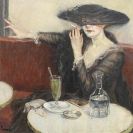
Impressionism
Impressionism (from the French word "impression") emerged as an art historical style in the last quarter of the 19th century in France. Impressionistic pictures have existed approximately since the 1860’s, and the path for them was cleared by the Barbizon school; the term "impressionism" itself however prevailed first in 1874 at the first exhibit of the impressionists, where Monet exhibited his harbor view with sunrise under the name "Impression soleil levant". The spontaneously chosen picture title reflected the basic attitude of the impressionists, who wanted to capture the fleeting impression and the atmospheric effect in their pictures, was so apt that this expression spread to the entire movement. The impressionists turned away from official academic art, and correspondingly, they did not paint in studios, but alla prima, directly in nature (plein air painting). In this way it was possible for them to capture short-lived light reflections, shadows or just simply impressions. In order for them to be successful at this, the impressionists had to transmit that which they had seen quickly onto the canvas. For this reason, the brush strokes of the impressionists were brief and comma-like. The impressionists also placed significant value on colorfulness; color transitions were rendered according to value, and shadows were represented in colors according to the impact of the light effect at that time. In impressionism, the reproducing itself became more important than that which was reproduced – the objects were alienated in that they were depicted as they seemed and not, for example, in the colors that they in fact were. A further characteristic of impressionism is the cutout-like composition which on the one hand reflects the ephemeral, but also developed from the influence of photography. From the exaggeration of this optical principle around 1885 came neoimpressionism or pointillism (main representatives are Georges Seurat, Paul Signac).
Important impressionist painters are among others: Edgar Degas, Edouard Manet, Claude Monet, Berthe Morisot, Camille Pissarro, Pierre-Auguste Renoir, Alfred Sisley.
Related artists: Balwé, Arnold | Baum, Paul | Bonnard, Pierre | Campendonk, Heinrich | Caspar-Filser, Maria | Cézanne, Paul | Corinth, Lovis | Corot, Jean-Baptiste-Camille | Cross, Henri-Edmond | Cucuel, Edward | Dill, Otto | Gauguin, Paul | Geiger, Willi | Hagemeister, Karl | Herbin, Auguste | Herrmann, Curt | Hölzel, Adolf | Klimsch, Fritz | Klinger, Max | Koester, Alexander | Kokoschka, Oskar | König, Leo von | Landenberger, Christian | Lebasque, Henri | Lehmbruck, Wilhelm | Leistikow, Walter | Levy, Rudolf | Liebermann, Max | Luce, Maximilien | Maillol, Aristide | Manet, Edouard | Meidner, Ludwig | Modersohn, Otto | Morandi, Giorgio | Morgner, Wilhelm | Munch, Edvard | Nolde, Emil | Ophey, Walter | Orlik, Emil | Overbeck, Fritz | Palmié, Charles Johann | Pechstein, Hermann Max | Picasso, Pablo | Pippel, Otto | Pissarro, Camille | Putz, Leo | Renoir, Pierre-Auguste | Rodin, Auguste | Rohlfs, Christian | Signac, Paul | Sintenis, Renée | Slevogt, Max | Steinlen, Théophile Alexandre | Toulouse-Lautrec, Henri de | Trübner, Wilhelm | Ury, Lesser | Utrillo, Maurice | Vuillard, Edouard | Weisgerber, Albert | Zügel, Heinrich von

Would you like to sell a work of Impressionism?
Infos for seller






